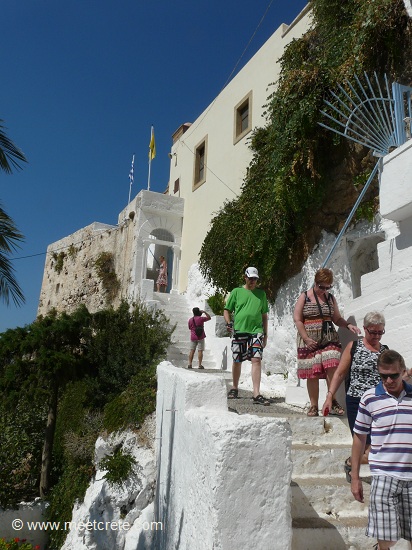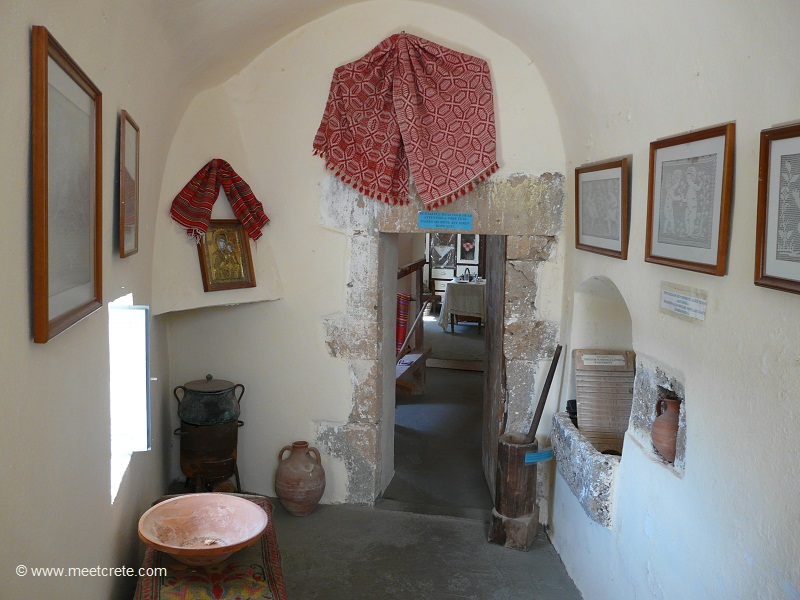The Holy Monastery Chrysoskalitissa is located 72 km south of Chania on the southwesternmost coast of Crete, only 5 km north of the exotic lagoon of Elafonisi. Its construction reminds of a fortress, perched on a 35m high rock with boundless sea views.
There is no written evidence for the start of the holy pilgrimage of Chrysoskalitissa
Tradition says that the sacredness of the site begins with the presence (finding) of the icon of the Virgin Mary in a niche of a rock. This icon had probably been hiding here since the iconoclasm 726-842 AD. In fact it is said to have been found by a farmer who saw the vision of a candle flame in the evenings. Before the monastery Chrysoskalitissa was built, there was another church in its place in the name of the Assumption. It was attached to a rock cave. On the roof of the rock there was another adjoining temple of the Holy Trinity.
Once, they decided to build a larger church and they thought it should be built at the foot of the rock, because so they could avoid the difficulties and the trouble of uploading material. It is said that while the icon had been transferred elsewhere, it mysteriously returned back to where it had originally been found. Everyone thought this was the will of Virgin Mary for her temple to be built on the rock, which was done.

The golden step
The name Chrysoskalitissa (golden step) comes from a golden step, the last of the ninety eight steps that existed then.
During the first years of Ottoman rule, the Patriarch was forced to sell the estates of the monastery as well as the golden step, to pay the heavy taxes imposed by the sultan, resulting in the devastation of the monastery. On Easter Sunday 1824 was the great massacre of Elafonisi by the Turk-Egyptians. They ruined ten churches on their way. They also passed by Chrysoskalitissa, which was deserted. They wanted to destroy it completely, but they were prevented by a swarm of bees, which had its hive in the niche of the shrine which you encounter when you enter the monastery.
The first person to live there after the devastation was a monk named Ioannikios from Kythera. After his death, a new devastation followed.


In 1855 began the revival of the monastery Chrysoskalitissa
by a monk called Manassis Karagiannakis. He was a descendant of the family of the Glyniades from Askifou in Sfakia. With the aid of subscriptions, he began renovating the dilapidated monastery and the ruins were transformed into new buildings.
After a few years, Emmanuel Kalitsounakis from Tzitzifes came to the monastery. He was ordained monk and took the name Meletios. Manassis brought the silver icon of the Virgin Mary from Smyrna. In 1866 Manassis died, leaving a small fortune that had been purchased by subscriptions and money. Meletios worthily continued the work of Manassis, and during those days the monastery was idiorrhythmic. Meletios was succeeded by Manassis aka Michael Katerinakis from Amygdalokefali. During the time of Manassis the old church was ruined and the rock was cut to make room for the building of the church we see today. The building began with eagerness and zeal on 9 May 1894 and ended on August 10 of that year. The inauguration took place on the day of the feast of the Assumption (15 August). In 1897 Manassis went abroad and was succeeded by Gregory Plokamakis (from Plokamiana) who served the Monastery Chrysoskalitissa more than half a century. Kazantzakis refers to him in his Report to Greco.
In 1900 the monastery Chrysoskalitissa was dissolved
along with other monasteries in Crete. It was reinstated as female in 1940.
After the conquest of Crete by the Germans, the Monastery hosted several soldiers, militants and others who belonged to the English spy. In 1943 the Germans moved to the monastery (after they had expelled the monks). Then they were shot by British planes. Signs of shooting can be seen on a low icon of the temple. Life returned after January 27, 1944 the day the Germans left. This life goes on continuously thanks to the friendly and active monks offering their services and keeping this sacred pilgrimage alive. (source: Holy Metropolis of Kisamos & Selinon)
- Of course you will combine your visit to the monastery Chrysoskalitissa with a visit to Elafonisi, one of Crete’s most exotic beaches
- Also you can drive until the magic beach of Kedrodasos – the beach for nature lovers
Holy Monastery Chrysoskalitissa – Useful information
Opening times: daily from 07.00 until 19.30 hrs
Entrance fee: 2 €

